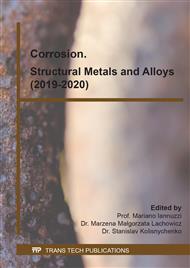[1]
J. Ptačinová, V. Sedlická, M. Hudáková, I. Dlouhý, P. Jurči, Microstructure – Toughness relationships in sub-zero treated and tempered Vanadis 6 steel compared to conventional treatment, Materials Science & Engineering. A 702 (2017) 241-258.
DOI: 10.1016/j.msea.2017.07.007
Google Scholar
[2]
P. Jurči, M. Dománková, M. Hudáková, J. Ptačinová, M. Pašák, Characterization of microstructure and tempering response of conventionally quenched, short- and long-time sub-zero treated PM Vanadis 6 ledeburitic tool steel, Materials Characterization. 134 (2017) 398-415.
DOI: 10.1016/j.matchar.2017.10.029
Google Scholar
[3]
P. Jurči, M. Dománková, L. Čaplovič, J. Ptačinová, J. Sobotová, P. Salabová, O. Prikner, B. Šuštaršič, D. Jenko, Microstructure and hardness of sub-zero treated and no tempered P/M Vanadis 6 ledeburitic tool steel, Vacuum. 111 (2015) 92-101.
DOI: 10.1016/j.vacuum.2014.10.004
Google Scholar
[4]
K. Amini, A. Akhbarizadeh, S. Javadpour, Effect of carbide distribution on corrosion behavior of the deep cryogenically treated 1.2080 steel, Journal of Materials Engineering and Performance. 25 (2016) 365-373.
DOI: 10.1007/s11665-015-1858-6
Google Scholar
[5]
J. Sobotova, P. Jurči, I. Dlouhy, The effect of subzero treatment on microstructure, fracture toughness, and wear resistance of Vanadis 6 tool steel, Materials Science & Engineering. A 652 (2016) 192-204.
DOI: 10.1016/j.msea.2015.11.078
Google Scholar
[6]
S. K. Bonagani, V. Bathula, V. Kain, Influence of tempering treatment on microstructure and pitting corrosion of 13 wt.% Cr martensitic stainless steel, Corrosion Science. 131 (2018) 340-354.
DOI: 10.1016/j.corsci.2017.12.012
Google Scholar
[7]
J. Wan, Y. Lou, H. Ruan, The partition coefficient of alloying elements and its influence on the pitting corrosion resistance of 15Cr-2Ni duplex stainless steel, Corrosion Science. 139 (2018) 13-20.
DOI: 10.1016/j.corsci.2018.04.038
Google Scholar
[8]
X. Cheng, Y. Wang, X. Li, C. Dong, Interaction between austein-ferrite phases on passive performance of 2205 duplex stainless steel, Journal of Materials Science & Technology. 34 (2018) 2140-2148.
DOI: 10.1016/j.jmst.2018.02.020
Google Scholar
[9]
S. Lu, K. Yao, Y. Chen, M. Wang N. Chen, X. Ge, Effect of quenching and partitioning on the microstructure evolution and electrochemical properties of a martensitic stainless steel, Corrosion Science. 103 (2016) 95 – 104.
DOI: 10.1016/j.corsci.2015.11.010
Google Scholar
[10]
ASTM G 102 – 89(2015)e1: Standard Practice for Calculation of Corrosion Rates and Related Information from Electrochemical Measurements, ASTM Book of Standards (2015).
Google Scholar
[11]
J. Ďurica, P. Jurči, M. Kusý, J. Ptačinová, M. Sahul, M. Pašák, Microstructural evaluation of tool steel Vanadis 6 after sub-zero treatment at -140 °C without tempering, Manufacturing Technology. 18 (2018) 222 - 226.
DOI: 10.21062/ujep/81.2018/a/1213-2489/mt/18/2/222
Google Scholar
[12]
D. Das, K.K. RAY, Structure – property correlation of sub-zero treated AISI D2 steel, Materials Science & Engineering. A 541 (2012) 45-60.
DOI: 10.1016/j.msea.2012.01.130
Google Scholar
[13]
M. Koneshlou, K. M. Asl, F. Khomamizadeh, Effect of cryogenic treatment on microstructure, mechanical and wear behaviors of AISI H13 hot work steel, Cryogenics. 51 (2011) 55-61.
DOI: 10.1016/j.cryogenics.2010.11.001
Google Scholar
[14]
A. Akhbarizadeh, K. Amini, S. Javadpour, Effects of applying an external magnetic field during the deep cryogenic heat treatment on the corrosion resistance and wear behaviour of 1.2080 tool steel, Materials & Design. 41 (2012) 114 – 123.
DOI: 10.1016/j.matdes.2012.03.045
Google Scholar
[15]
C.L. Briant, A. M.Ritter, The effect of cold work on the sensitization of 304 stainless steel, Scripta Metallurgica. 13 (1979) 177 – 181.
DOI: 10.1016/0036-9748(79)90288-6
Google Scholar
[16]
J. Wu, B. Wang, Y. Zhang, R. Liu, Y. Xia, G. Li, W. Xue, Enhanced wear and corrosion resistance of plasma electrolytic carburized layer on T8 carbon steel, Materials Chemistry and Physics. 171 (2016) 50-56.
DOI: 10.1016/j.matchemphys.2015.09.047
Google Scholar



